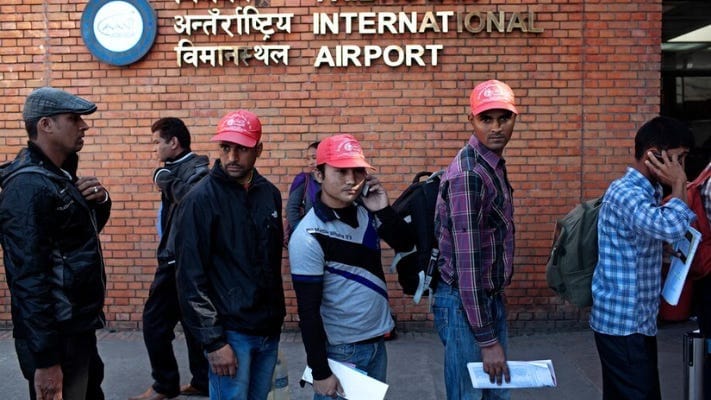Image: WP
At Kathmandu’s Tribhuvan International Airport, the departure hall is the closest thing Nepal has to a factory floor. Every evening, queues of men in identical polo shirts and plastic sandals inch toward the immigration desk. Their paperwork bears different destinations—Doha, Dubai, Dammam—but the same purpose: escape. What most countries call labour mobility, Nepal calls development.
That the country’s best jobs lie abroad is no surprise. What is stunning is how smoothly its economy has adjusted to that reality. In the fiscal year ending in mid-2025, more than 800,000 Nepalis left on foreign employment contracts—roughly 7% of the labour force. The state, unable to create work, has perfected the art of exporting it. Migration has become Nepal’s most productive industry, even if its profits accrue elsewhere.
The flows, though, are shifting. Consider Malaysia. Two years ago it hired 219,000 Nepalis, making it their top destination. Last year it took just over 10,000. The reason was not war or demand but paperwork: Nepal’s labour ministry tightened vetting rules; Malaysia’s bureaucracy responded by freezing approvals. A 2018 bilateral deal, drafted with fanfare, proved too vague to enforce. When one bottleneck forms, the market reroutes.
The Gulf swiftly filled the gap. The United Arab Emirates tripled its Nepali intake in two years, from 59,000 to over 200,000, while Saudi Arabia and Qatar absorbed much of the rest. The arrangement suits both sides: Gulf economies need workers without rights; Nepalis need wages without prospects. Deployment is fast, turnover high, oversight minimal. The system treats labour like crude oil—refined abroad, remitted back.
A quieter current flows east. Japan and South Korea are luring a different kind of migrant: tested, trained, and vetted. In 2024–25 Japan welcomed nearly 19,000 Nepalis under its “Specified Skilled Worker” visa; South Korea took 14,000 through its Employment Permit System. The rewards are higher—a Japanese caregiver earns roughly ¥180,000 ($1,200) a month, four times Gulf pay—but so are the entry costs. Language tests and training fees filter out all but the educated or well-connected. Migration, once a social leveller, now amplifies inequality.
Europe, too, has joined the game. Romania, short of hands and long on ageing, recruited 22,000 Nepalis last year—more than Malaysia did. Most work in hotels, farms or care homes. For many, Bucharest is a pit stop to the Schengen zone. Poland, once a hopeful corridor, has cooled as it prioritised Ukrainians and Moldovans. Nepal’s migration map thus mirrors Europe’s demographic panic: the labour shortages of the old world are being filled by the young from the Himalayas.
Remittances have turned this flow into Nepal’s most reliable macroeconomic stabiliser. They now make up nearly a quarter of GDP—more than manufacturing, construction and tourism combined. They fuel rural consumption, anchor the rupee and inflate Kathmandu’s housing market. For millions of families, they are the only form of social insurance. Policymakers admire the resilience; they rarely ask what sustains it.
The answer is debt. A ticket to Qatar costs the average worker more than a year’s income—about 1.14 times Nepal’s per-capita GDP. The “free-visa, free-ticket” policy introduced in 2015 exists mostly in speeches. Surveys suggest that 85% of migrants still pay illegal recruitment fees, often financed through informal loans at 25–30% interest. A 22-year-old from Rupandehi district describes his routine: “First you borrow to go abroad. Then you work to pay the loan. When it’s done, you go again.” The cycle is steady enough to count as policy.
The geography of migration has become a map of class. In richer provinces such as Bagmati and Gandaki, the share of workers heading to Japan, Korea and the West has jumped by nearly 20 percentage points since 2011. In poorer regions—Karnali, Lumbini, the Terai plains—India remains dominant, not for its wages but its bus routes. Caste and education sharpen the divide: upper-caste families and graduates are far more likely to access premium corridors, while marginalised groups stay trapped in low-return cycles. Migration, like schooling or land, is an inherited advantage.
Even when it works, the gains are fleeting. About 70% of remittances go on daily consumption; another 20% pays back loans. The rest is typically parked in land, concrete or private schooling. Productive investment is rare. Government attempts to sell “remittance bonds” or fund start-ups have yielded press releases rather than results. As one central banker admits, “We have turned human capital into foreign exchange.”
The longer this continues, the harder it is to reverse. With its most ambitious citizens abroad, Nepal’s domestic labour market has gone slack. More than 60% of workers still till fields for meagre returns. Industry creation is sluggish, services stagnant. The economy has adapted to export dependency so completely that even remittance downturns fail to trigger reform; they simply raise borrowing.
None of this makes the system irrational. It is a network of incentives that works too well. Migrants earn, recruiters profit, families consume, and the state collects taxes without creating jobs. The model depends only on foreigners’ willingness to hire and Nepalis’ willingness to leave. Should either falter—say, through Gulf visa curbs or European populism—the machine would seize up.
At the airport, the queues still form each night. The fluorescent lights hum and another batch of departures shuffles forward. It is the sound of an economy running at full capacity—somewhere else. ■

